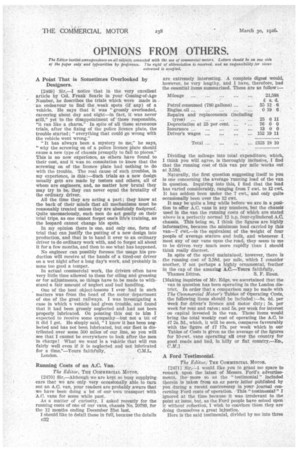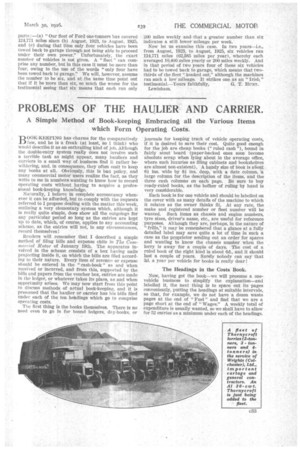OPINIONS FROM OTHERS.
Page 30

Page 31

If you've noticed an error in this article please click here to report it so we can fix it.
The Editor inVites correspondence on all sztbjests COMV,Cted with the use of commercial motors, Letters should be on One side at the aper only and typewritten by prelereaca The right of abbreviation is reserved, and no responsibility /or views
A Point That is Sometimes Overlooked by Designers.
[2469] Sir,-1 notice that in the very excellent article by Col. Frank Searle in your Coming-of-Age Number, he describes the trials which were made in --an endeavour to find the ,weak spots (if any) of a vehicle. He says that it was "grossly overloaded, caieering about day and night—in fact, it was never still," yet to the disappointment of those responsible, "it ran like a charm." In spite of all these strenuous trials, after the fixing of the police licence plate, the trouble started; "everything that could go wrong with the vehicle went wrong."
"IL has always been a mystery to me," he says, "wily the screwing on of a police licence plate should cause a new type of chassis promptly to fall to pieces." This is no new experience, as others have found to their cost, and it was no consolation to know that the screwing on of the licence plate had nothing to do with the trouble. The real cause of such troubles, in my experience, is this :—Such trials as a new design usually gets are made by testers and others, all of whom are engineers, and, no matter how brutal they may try to be, they can never equal the brutality of the ordinary driver.
All the time they are acting a part ; they know at the back of their mind's that all mechanisms must be reasonably treated unless they are absolutely foolproof. Quite -unconsciously, such men do act gently on their trial trips, as one cannot forget one's life's training, as the leopard cannot change his spots.
In my opinion there is one, and only one, form of trial that can justify the putting of a new design into production, and that is to hand it over to an ordinary driver to do ordinary work with, and to forget all about It for a few months, and then to see what has happened.
No engineer can possibly foresee the usage his production will receive at the hands of a tired-out driver on a wet night after a long day's work, and probably in none too good a temper.
In actual commercial work, the drivers often have very little time allowed to them for oiling and greasing or for adjustments, so things have to be made to withstand a fair amount of neglect and bad handling.
One of the best object-lessons I ever had in such matters was from the head of the motor department of one of the great railways. I was investigating a case in which a vehicle had given trouble, and found that it had been grossly neglected and had not been properly lubricated. On pointing this out to him expected to receive some sympathy—but not a bit of it did I get. He simply said, "1 know it has been neglected and has not been lubricated, but our fleet is distributed over some 500 miles of our line, so you will see that I cannot be everywhere to look after the men in charge! What we want is a vehicle that will run fairly well even if it is neglected and not lubricated for a time."—Yours faithfully, London.
Running Costs of an A.C. Van.
The Editor, THE COMMERCIAL MOTOR.
[2470] Sir,—Alrhough we are kept so busy supplying cars that we are only very occasionally able to turn out an A.G. van, your readers are probably aware that we have been doing a lot of our own transport with A.C. vans for some while past.
As a matter of curiosity, I asked recently for the running costs of one of our vans, chassis No. 20789, for the 12 months ending December 31st last.
I should like to detail these in full, because the details c32
are extremely interesting. A complete digest would, however, be very lengthy, and I have, therefore, had the essential items summarized. These are as follow:—
Dividing the mileage into total expenditure, which, I think you will agree, is thoroughly inclusive, I find that the running cost of this van per mile works out at 3.58d.
Naturally, the first question suggesting itself to you is one concerning the average running load of the van in question. Inquiring into this, I find that the load has varied considerably, ranging from 7 cwt. to 12 cwt. It has seldom been under the 7 cwt., and only quite occasionally been over the 12 cwt.
It may be quite a long while before we are in a position to offer A.C. vans in any numbers, but the chassis used in the van the running costs of which are stated above is a perfectly normal 12 h.p. four-cylindered A.C. chassis. This being so, I think the figures are highly informative, because the minimum load carried by this van-7 cswt.—is the equivalent of the weight of four people of average stature and bulk, and whenever I meet any of our vans upon the road, they seem to me to be driven very much more rapidly than I should think really discreet.
In spite of the speed maintained, however, there is the running cost of 3.58d. per mile, which I consider another, if not perhaps a highly ornamental, feather in the cap of the amazing A.C.—Yours faithfully, Thames Ditton. S. F. EDGE.
[Making inquiries of Mr. Edge, we ascertained that the ' van in question has been operating in the London district. In order that a comparison may be made with The Commercial Afotor'8 Tables of Operating Costs, the following items should be included :-8s. 4d. per week for driver's licence and motor duty ; 5s. per week for rent and rates; and 5s. per week for interest on capital invested in the van. These items would bring the total weekly cost of operating the A.C. to £7 2s. 3(1., which, it will be seen, compares favourably with the figure of £7 17s. per week which in our Tables of Costs is given as the average of the figures for 10-cwt. vans operating all over the country for good roads and bad, in hilly or fiat country.—En., Cif .1
A Ford Testimonial.
The Editor, TEE COMMERCIAL MOTOR.
[2471] would like you to grant me space to remark upon the latest of Messrs. Ford's advertisements, the-j more so as the " testimonial " included therein is taken from an ex parte letter published by you during a recent controversy in your journal concerning Ford costs of operation. This " testimonial" I ignored at the time because it was irrelevant to the point at Issue, but, as the Ford people have seized upon it without reflection, I wish to convince them they are doing themselves a great injustice.
Here is the said testimonial, divided by me into three parts :—(a) "Our fleet of Ford one-tonners has covered 124,771 miles since (b) August, 1923, to August, 1925, and (c) during that time only four vehicles have been towed back to garage through,not being able to proceed under their own power." Unfortunately, the exact number of vehicles is not given. A " fleet " can Comprise any number, but in this case it must be more than four, owing to the use of the words "only four have been towed back to garage." We will, however, assume the number to be six, and at the same time point out that if it be more than six, so 'much the worse for the testimonial seeing that six means that each ran only 200 miles weekly and that a greater number than six indicates a still lower mileage per week.
Now let us examine this case. In two years—i.e., from August, 1923, to August, 1925, six vehicles ran 124,771 miles (62,385 miles per year), whereby each averaged 10,400 miles yearly or 200 miles weekly. And in that period of two years four of these six vehicles had to be towed back to garage, which means that twothirds of the fleet " konked out," although the machines ran such a low. mileage. • It strikes one as an -" Irish"
testimonial.—Yours faithfully, G. T. HUNT, Lewisham.


































